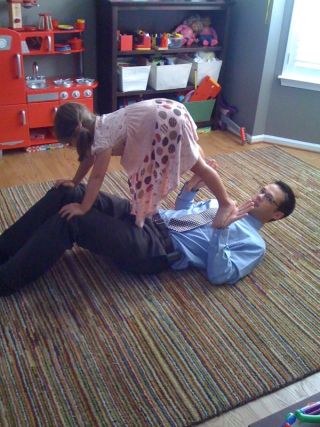Confidence
Larry’s Rules of Roughhousing
10 tips for safety and fun.
Posted March 19, 2023 Reviewed by Jessica Schrader
Key points
- Parent-child roughhousing can be safe if you follow some simple guidelines.
- It's also lots of fun.
- Roughhousing can be great for child development and family harmony.
Below are 10 "rules" to keep family roughhousing fun and safe.
1. Provide basic safety, but don’t worry too much
Maria Brussoni, a professor at the University of British Columbia who studies the benefits of risky play and outdoor play, suggests using the phrase “as safe as necessary” instead of “as safe as possible.” She not only studies risks but takes risks herself, by advocating the radical idea that we should make playgrounds a little more risky for children. She writes, “Keeping children safe means letting them take risks, because in risky play they learn how the world works, how their bodies work, and how to manage risk effectively.”
Ellen Sandseter, professor of early childhood education at Queen Maud University College in Trondheim, Norway, recommends six types of risks for healthy child development. How much of this list can you read without going into fight-or-flight-or-freeze mode?
- Heights.
- Speed.
- Tools.
- Location near something dangerous.
- Rough and tumble.
- Getting temporarily lost.
If that list scared you, you're not alone. But don't rush to ban this kind of play. Children need it. When it comes to roughhousing, basic safety comes from having a dedicated area free from sharp edges and away from glass doors. Instead of enforcing safety with rules, increase safety by being nearby and offering your trust and confidence.

2. Look for every chance to connect
Many parents are afraid of roughhousing because it seems aggressive. But good rough-and-tumble play is more like dancing than fighting. I like to start every roughhousing session with a good strong connection, such as a hug, shaking hands, high fives, or bowing to one another “to show respect before fighting to the death!” as one young boy put it to me. Then it’s great to end roughhousing with another symbolic connection. During roughhousing play you can build connection by tuning in to your child, noticing their intensity level, their eye contact, and their mood.
3. Look for every chance to build confidence
Roughhousing builds confidence in children, as long as adults or older children don’t dominate and overpower smaller children. Give children just-right-sized challenges.
4. (Usually) the child wins
Don’t be afraid of letting children win when you wrestle or have a pillow fight. They won’t become over-confident or lose their respect for you. On the contrary, they will learn a vital moral lesson, that bigger people should hold back their superior strength during play so that it remains fun for everyone.
5. Pause immediately when someone is hurt
Pause for comfort, ice, or bandages—especially comfort, even if the injury is small. Even if the injury is imaginary! The purpose of roughhousing is not to toughen kids up, but to let them know that they can be physically and emotionally safe even while using all their strength and power. However, there is no need to stop the game abruptly just because of a minor injury or some tears. Provide comfort, listen empathically to the tears, then get back to playing.

6. No holding children down and tickling them
Many of us have memories of being held down and tickled by bigger people who didn’t stop when we said stop. The involuntary laughter can give a mixed signal. But we still do this to children, because we want that rewarding burst of laughter. Unfortunately, this kind of tickling overwhelms the nervous system. A quick little jab-tickle, or even a pretend tickle without touching the child’s body, can be less overstimulating, and bring a more enjoyable type of laughter. This habit of tickling can be hard to unlearn when it is your go-to way to enjoy physical play, but it is worthwhile to tone it down, especially for children who have a hard time regulating their emotions and behaviors.
7. Good signs: Giggling, happy exertion
You know you are on the right track when you hear the sound of giggling, or you see a child working hard, in a joyful way, to tackle you or bop you with a pillow.
8. Let your child be the one who is stronger and more competent
I like to exaggerate my abilities—“You will never knock me over … You will never escape!” and then act very surprised when kids knock me over and escape from my grasp.
9. Warning signs: Blind rage, no eye contact
Roughhousing can bring big feelings to the surface. If those feelings are excitement and joy, keep playing! If it is sadness and loss—which can be aroused by happy play because of the sense of safety and security that comes from closeness and connection—then pause to offer comfort. If intense angry feelings erupt from the playful roughhousing, take a break to address those feelings directly. It’s not play anymore if someone is getting hurt or is overwhelmed with rage.
10. When in doubt, fall over!
Keep it simple. Young children especially love to give you a little push and have you fall over dramatically. If that makes them laugh—do it again. And again…
For more tips, some awesome moves, and exclusive downloads, check out my new book, co-authored with Anthony Debenedet: Unplug and Play: The Ultimate Illustrated Guide to Roughhousing with Your Kids.




